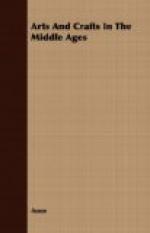Ecclesiastical embroidery began in the fourth century. In earliest days the work was enhanced with quantities of gold thread. The shroud in which St. Cuthbert’s body was wrapped is a mass of gold: a Latin inscription on the vestments in which the body was clad may be thus translated: “Queen to Alfred’s son and successor, Edward the Elder, was one Aelflaed, who caused this stole and maniple to be made for a gift to Fridestan consecrated Bishop of Winchester, A. D. 905.” The maniple is of “woven gold, with spaces left vacant for needlework embroidery.” Such garments for burial were not uncommon; but they have as a rule perished from their long residence underground. St. Cuthbert’s vestments are splendid examples of tenth century work in England. After the death of King Edward II., and his wife Aelflaed, Bishop Frithestan also having passed away, Athelstan, as King, made a pilgrimage to the shrine of St. Cuthbert and bestowed these valuable embroideries there. They were removed from the body of the saint in 1827. The style of the work inclines to Byzantine. The Saxon embroideries must have been very decorative: a robe is described by Aldhelme in 709, as “of a most delicate thread of purple, adorned with black circles and peacocks.” At the church at Croyland some vestments were decorated with birds of gold cut out and applique and at Exeter they had “nothing about them but true needlework.”
In the “Liber Eliensis,” in the Muniment room at Ely, is an account of a gift to the church by Queen Emma, the wife of King Knut, who “on a certain day came to Ely in a boat, accompanied by his wife the Queen Emma, and the chief nobles of his kingdom.” This royal present was “a purple cloth worked with gold and set with jewels for St. Awdry’s shrine,” and the Monk Thomas assures us that “none other could be found in the kingdom of the English of such richness and beauty of workmanship.”
The various stitches in English work had their several names, the opus plumarium, or straight overlapping stitches, resembling the feathers of a bird; the opus pluvarium, or cross stitch, and many others. A great deal of work was accomplished by means of applique in satin and silk, and sometimes the ground was painted, as has already been described in Italian work. In the year 1246 Matthew Paris writes: “About this time the Lord Pope, Innocent IV., having observed that the ecclesiastical ornaments of some Englishmen, such as choristers’ copes and mitres, were embroidered in gold thread, after a very desirable fashion, asked where these works were made, and received in answer, ‘England.’ Then,” said the Pope, “England is surely a garden of delight for us; it is truly a never failing Spring, and there where many things abound much may be extorted.” This far sighted Pope, with his semi-commercial views, availed himself of his discovery.
In the days of Anastatius, ecclesiastical garments were spoken of by name according to the motive of their designs: for instance, the “peacock garment,” the “elephant chasuble,” and the “lion cope.” Fuller tells of the use of a pall as an ecclesiastical vestment, remarking tersely: “It is made up of lamb’s wool and superstition.”




